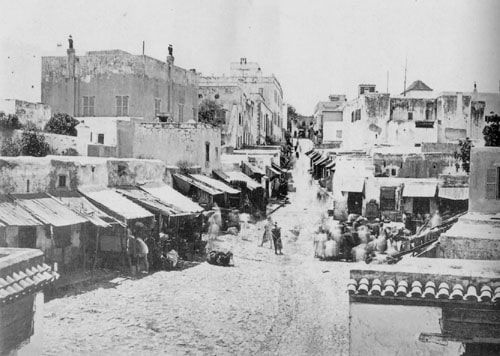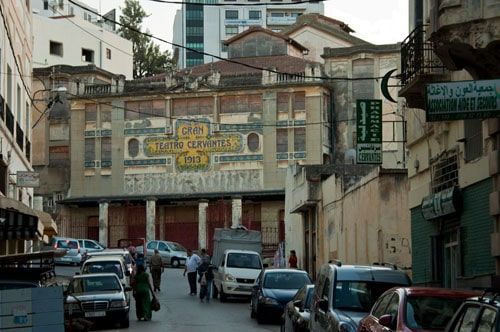Tangier: the city that spoke in Spanish
A melting pot of cultures, where Jews, Christians, and Muslims coexisted without mixing, Tangier was an open city, where each social and ethnic group preserved its identity. Spanish was the common language.

A coastal city in northern Morocco, Tangier is located on the Strait of Gibraltar. It is the current capital of the Tangier-Tetouan region. But Tangier is portrayed, graphically and literarily, as a magical city, as an independent space. Where is the charm and magic of Tangier located? Is there a specific place that defines the city? Tangier is the location, that place of mythical geography, of geo-mythology between two seas, Atlantic and Mediterranean; between two continents, Africa and Europe. With many ancestral cultures around: there are Hebrew sediments, from the time of their expulsion from the kingdoms of Castile and Aragon.
It is even an ugly city. How is it that a city that is no prettier than Casablanca, for example, has such a magical and special point? Because of history? Its history has passed. It is now a very Moroccan city. However, it maintains that point that would make most of those who lived there, who now live in other countries, come back to the city. Because something happened in the city that enchanted them in those times. It is what makes up its magical history, created by politics, created by the international situation. Because magic is created by accident if we understand by historical and social accident its geographical situation and being the object of desire of the governments of many countries.
History of Tangier
In the documented history of Tangier, the Andalusian caliph Abderraman III had Tangier, Ceuta and Melilla under his rule. The cities remained under Arab control until the reign of Hisham III. From the year 1026, it belonged to the Taifa of Malaga. In those years Tangier received the nickname "The white".
Coveted by all, in 1437 a Portuguese expedition of conquest by Henry the Navigator failed. In 1464, during the reign of Alfonso V of Portugal, a Portuguese fleet under the command of Luis Mendez de Vasconcellos tried to seize the city. The Portuguese will have to wait until August 28, 1471, to take and occupy the city, which will remain under the dominion of Portugal and Spain until 1661. The Portuguese allied themselves with England, marrying in 1661 the Infanta Catherine of Braganza to Charles II of England. Tangier was part of the bride's dowry. The English monarch declared in Parliament: "The acquisition of Tangier must be regarded as a priceless jewel for the British crown".
In 1679 Sultan Ismail tries to conquer the city. He blockaded Tangier until he achieved the British retreat on February 6, 1684. Before leaving, the British razed the city and the port. The sultan ordered the reconstruction of the city - the population did not exceed 5,000 inhabitants - which will not recover until the beginning of the 19th century.
The Strait of Gibraltar, in the 18th century, had a great strategic value as the Atlantic entrance to the Mediterranean. The most important countries of Europe and the West will set their eyes on the north coast of Africa, in its western part. In 1786 Tangier became the diplomatic capital of Morocco. In the city will be installed the consulate of Spain, and the first delegation abroad of the United States (1797). In 1821 Sultan Sulayman gives the embassy building (bombed years later by the French in 1844) to the U.S. government.
The political tensions in Europe and the nationalisms, the settlement of totalitarianisms, will provoke warlike escalations sheathed in nationalism. Africa will be the great colony of the European powers: England, France, Germany, Belgium will divide up some lands, manufacturing countries. Tangier's location made the city an important commercial center for Morocco and the center of European diplomacy. In 1905, Kaiser Wilhelm II pronounces the continuity of Moroccan independence: it provokes an international crisis.
In the 20th century, all the eyes of the European and Western powers were on Tangier. And they were not willing for it to be under the political and commercial control of Morocco. In 1925, Belgium, Spain, the United States, France, the Netherlands, Portugal, the United Kingdom, and the USSR agreed at the Algeciras Conference on the condominium of the city, which would become the "Tangier International Zone". From June 14, 1940, the day on which the Nazi troops occupied Paris, until 1945 the city was occupied by troops sent by Franco. The occupation was not accepted by any country, except Nazi Germany. When the Allied Army advanced towards Germany, Franco's army withdrew and declared Tangier an open city.

Refuge of artists and intellectuals
For twenty years, between 1940 and 1960, the city was an international zone, a refuge of writers, intellectuals, artists. Zone of revelry and sexual excesses of eccentric millionaires, map of secret agents, the souk of swindlers, stock exchange of speculators, and swindlers, hotel of lovers of the good life. Tangier was like a powerful light bulb that attracted all kinds of creatures of the night.
Truman Capote is said to have said that "Before the Acropolis, some feel in a state of wisdom; before St. Peter's in Rome, others reach a state of grace; and before the small souk of Tangier, all feel in a state of freedom". True or false, the phrase is an approximation to the free atmosphere of a free and multicultural city, where Jews, Muslims, and Christians have coexisted without mixing.
Tangier has been the great little oasis of absolute freedom for artists, writers, and intellectuals; although understanding their freedom as an easy and cheap way of life. They were the masters: they could get drugs and alcohol without limit, at low prices; they could have sex with boys and girls, for very little money, without anyone reproaching them for their behavior. Paul and Jane Bowles, William Burroughs, Jack Kerouac, Truman Capote, Tennessee Williams, Barbara Hatton, Jean Genet, Francis Bacon, Brion Gysin, Patricia Highsmith. Although it provoked some identity crises, the different social groups enjoyed an easy and cheap life and were never interested in the problems of the Moroccans. They were alien to their intellectual or emotional interests.
Among all those writers and intellectuals of Saxon culture and English language who made Tangier a universal myth, Paul Bowles stands out who, in 1947, settled in the city with his wife, Jane Auer, later Jane Bowles, a bisexual writer who would end up locked up in a psychiatric hospital in Malaga, where she would die fifteen years after her admission. And it was in Morocco that Bowles set most of his stories, starting with "The Sheltering Sky" (1949). His memoirs "Without Stopping" (1972) were very shocking for their crudeness and lack of modesty.
And he translated out of friendship as if he had contracted some moral debt, "The Naked Bread" (1973), by the Moroccan Hispanist and writer Mohamed Chukri, a very harsh biographical account of his life: the work was banned until the year 2000, for its descriptions of child prostitution, for showing the hatred of his father, a violent alcoholic, towards his family, for narrating the sexual abuse he suffered. Chukri, gifted with an extraordinary natural talent, translated into Arabic Gustavo Adolfo Becquer, Antonio and Manuel Machado, Vicente Aleixandre, Garcia Lorca.
Tangier was also home to the glamorous "Gay Society", with complete freedom, undisguised, enjoying cheap sex with minors, with its big names: Visconti, Tennesee Williams, Truman Capote. Also, prominent members of the Beat Generation passed through the city: William Burrough, Allen Ginsberg, Jack Kerouac, addicted to drugs, especially the Moroccan "majoun".
Artistically, Delacroix made the city an obligatory stop for painters in search of light and color. There was no shortage of Spaniards, such as Mariano Fortuny, author of "Zoco de Tangier", which is preserved in the Hispanic Society of America (New York); nor French impressionists, such as Matisse, who always stayed at the Hotel Villa de France. The Californian painter Richard Diebenkorn also visited. The light and color of the city have always been irresistible.
The end of Tangier's special status came to an end in 1956, with Morocco's independence. France returned the occupied territories to Morocco and Tangier will begin a process of annexation that will culminate on April 18, 1960. Surprisingly, a year later, in 1961, the cathedral of Tangier was built: it was intended to symbolize the presence of Franco's Spain in North Africa and the Catholic Franciscan mission.

Abundant Spanish traces
Tangier has been historically linked to Spain, since the Arab-Muslim period, in the 8th century. It was a commercial port, a gateway to Africa, a few kilometers from the southern Hispanic coasts. It was the link between the European and North African cultures, represented by the Rifian tribes.
Among the mythical places of Tangier: the grotto of Hercules, the Café Hafa, the Bullring, the Cervantes Theater. The Grotto of Hercules, five kilometers from Cape Espartel, 17 kilometers from the city center, is a whim of nature. In the area, there are ruins from Roman times. The Café Hafa, built-in 1921, in a natural enclave near the Marshan neighborhood, in the bay of the city, has terraces staggered overlooking the Strait of Gibraltar. It was the place for writers, intellectuals, and artists from all countries. The Spanish singer-songwriter Luis Eduardo Aute, after passing through the Hafa composed a song with his name.
The Cervantes Theater, the largest in Africa at the time, opened in 1913. The city then had about 50,000 inhabitants (more than 10,000 Spaniards). The Hispanic footprint was seen in every corner, including stores and restaurants. Spanish predominated over other languages. The Cervantes, the largest coliseum in North Africa, emblem and manifestation of Spanish colonial splendor, will be the meeting point of the Spanish colony, in which there are names of its own: Eduardo Haro Tecglen, Juanita Narboni, Angel Vazquez, Diego Jimenez.
On the stage of the theater performed from Caruso to Imperio Argentina, Miguel de Molina, Concha Piquer, Juanito Valderrama, Manolo Caracol, Antonio Machin. The testimony of Juanito Valderrama, collected in Letter from Spain number 630 (September 2007), page 35, is convincing: "When I sang in that wonderful theater, Tangier was neither Spain, like Tetouan; nor France, like Casablanca. All languages were spoken there and all religions were practiced. It had all the attractions of the world and most of them performed at the Cervantes Theater".
Spain would abandon Tangier when Morocco became independent. Franco's Spain did not want to know anything about the city, letting time fade the traces of the Hispanic presence. France and England will maintain their presence, their culture. Later, the Alaouite monarch Hassan II, trying to erase the western traces, repopulated the city with Moroccans from the south, alien to the culture of the city. The city, since then, will grow, will extend, and will come to have more than two million inhabitants.
In Tangier, up to three Spanish newspapers were published: "El Porvenir", "Africa" and "Spain" (between 1938 and 1967). The journalist Eduardo Haro Tecglen was editor-in-chief of the newspaper "Africa" in 1946 and director of España in 1967. It should be added that Spanish magazines such as "La Crónica", "Democracia", "Diario de Tánger", "Presente" were also published.
Such a profusion of media gives an idea of the magnitude of the presence of Spain in the city, where a good handful of writers and Spanish-Tangerine or Spanish artists linked to Tangier carried out their work: José Hernández, painter; Diego Galán, screenwriter and film critic; Eduardo Haro Tecglen, journalist; José Ramón da Costa, filmmaker. Plus Alberto Gómez-Font, Isabella Degioanni, Emilio Sanz de Soto, Pepe Carleton. For all of them, Tangier was another Andalusian corner of Spain. It meant light, color, freedom, in a time of leaden years in the metropolis.
By Pablo Torres




